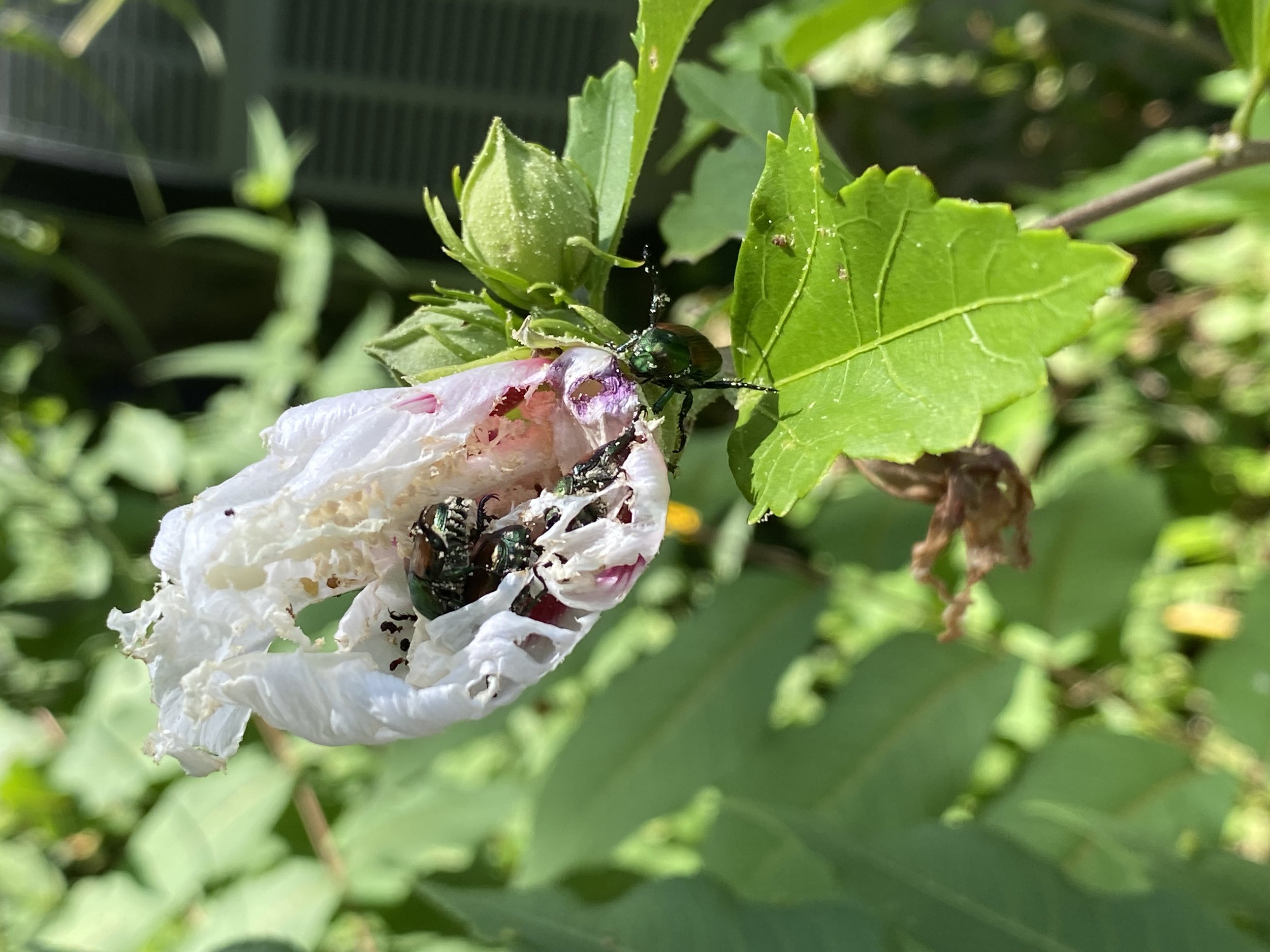Fighting Japanese Beetles
/japanese beetles dining on my white hardy hibiscus blooms. (charlotte ekker wiggins photo)
Fighting Japanese Beetles
Darn it, I forgot to ask my brother who lives in Virginia if Japanese beetles were ravaging his lovely crape myrtles this year. Years ago about this time, he was filing up 5 gallon buckets with these iridescent invasives. For his birthday, I shipped him 250,000 nematodes to treat his soil. Those microscopic worms eat the Japanese beetle grubs and reduce next year’s population.
The 3/8th of an inch hard shell beetles are eating machines, devouring more than 200 plant species. Once they turn from grubs into beetles, they set off a scent that says "let's party" to other Japanese beetles, yet another reason why you shouldn’t crush the bugs, no matter how tempting.
If you don't see them, you'll know you have them when your plant leaves turn into lace.
Prior to the beetle's accidental introduction into the United States, the Japanese beetle was found only on the islands of Japan, isolated by water and kept in check by its natural enemies. The beetles entered the country as grubs in soil on Japanese iris roots. By 1920, eradication programs were dropped; the beetle proved to be too prolific of a breeder.
One of the popular options to eliminate these voracious bugs is Japanese beetle traps, which I don’t recommend. Those are basically pheromone-laced paper bags that attract Japanese beetles. The challenge is the bags don’t catch all of them so having more Japanese beetles in your garden means more potential grubs to hatch out next year.
If you insist on using Japanese beetle traps, make sure you place them at the edge of your property and down wind.
Another friend who has chickens uses Japanese beetle traps to collect Japanese beetles, then transfers them to plastic bags and freezes them. The frozen bugs are then fed to her chickens as treats.
What has worked very well for me over the years is dropping them in a can of soapy water early morning, while they are still sluggish. I pop the soapy water-filled coffee can underneath plant branches, then shake them. The bugs fall into the water without my touching them. I’ll confess I have squished a few, especially when I’ve suspected they’re hiding inside my hardy hibiscus flowers. Sometimes they won’t drop out when I shake them so I have to remove the flower head.
For a long term solution, my brother in Virginia has treated his lawn with milky spores. He has dozens of crepe myrtles, one of Japanese beetles favorite munchies. According to him, Japanese beetle grubs eat the spores; get sick; die and, in the process, release more milky spores. It can take several years to eliminate the Japanese beetles, not counting whether your neighbors have treated their lawns.
There are plants Japanese beetles avoid. The typical kind of plant that will help to drive away Japanese beetles will be strong smelling and may taste badly to the insect. Some plants that deter Japanese beetles include many herbs as garlic, rue, tansy, catnip and chives. Other Japanese beetle deterrent plants include white chrysanthemums, leeks, onions, marigolds, white geraniums and larkspur.
There are also plants that Japanese beetles skip or only munch on towards the end of their season. I assume these are just not tasty plants: begonias, caladiums, common lilacs, common pear, tulip tree, flowering dogwood, forsythia, hydrangea, hickory, magnolia, persimmon and most oak trees.
Ok, time to soap up and start picking off those pesky bugs!
For more gardening, beekeeping, cooking and easy home decor tips, subscribe to Garden Notes.
Charlotte













